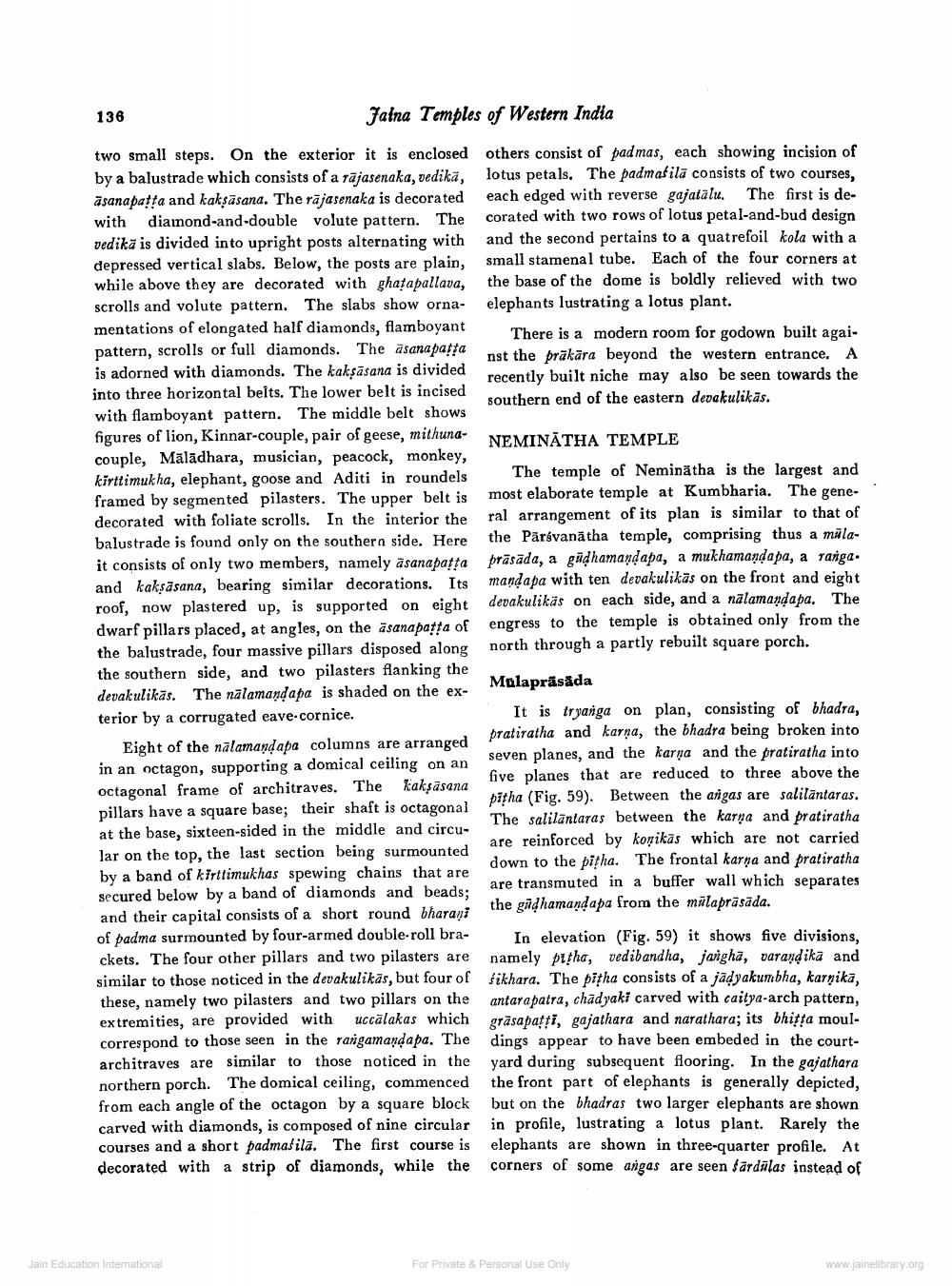________________
136
two small steps. On the exterior it is enclosed by a balustrade which consists of a rajasenaka, vedikā, asanapaṭṭa and kakṣāsana. The rajasenaka is decorated with diamond-and-double volute pattern. The vedikä is divided into upright posts alternating with depressed vertical slabs. Below, the posts are plain, while above they are decorated with ghatapallava, scrolls and volute pattern. The slabs show ornamentations of elongated half diamonds, flamboyant pattern, scrolls or full diamonds. The asanapata is adorned with diamonds. The kakṣāsana is divided into three horizontal belts. The lower belt is incised with flamboyant pattern. The middle belt shows figures of lion, Kinnar-couple, pair of geese, mithunacouple, Maladhara, musician, peacock, monkey, kirttimukha, elephant, goose and Aditi in roundels framed by segmented pilasters. The upper belt is decorated with foliate scrolls. In the interior the balustrade is found only on the southern side. Here it consists of only two members, namely asanapaṭṭa and kakṣāsana, bearing similar decorations. Its roof, now plastered up, is supported on eight dwarf pillars placed, at angles, on the asanapaṭṭa of the balustrade, four massive pillars disposed along the southern side, and two pilasters flanking the devakulikās. The nalamanḍapa is shaded on the exterior by a corrugated eave-cornice.
Jaina Temples of Western India
Eight of the nalamanḍapa columns are arranged in an octagon, supporting a domical ceiling on an octagonal frame of architraves. The kakṣāsana pillars have a square base; their shaft is octagonal at the base, sixteen-sided in the middle and circular on the top, the last section being surmounted by a band of kirttimukhas spewing chains that are secured below by a band of diamonds and beads; and their capital consists of a short round bharani of padma surmounted by four-armed double-roll brackets. The four other pillars and two pilasters are similar to those noticed in the devakulikäs, but four of these, namely two pilasters and two pillars on the extremities, are provided with uccalakas which correspond to those seen in the rangamaṇḍapa. The architraves are similar to those noticed in the northern porch. The domical ceiling, commenced from each angle of the octagon by a square block carved with diamonds, is composed of nine circular courses and a short padmašila. The first course is decorated with a strip of diamonds, while the
Jain Education International
others consist of padmas, each showing incision of lotus petals. The padmafila consists of two courses, each edged with reverse gajatälu. The first is decorated with two rows of lotus petal-and-bud design and the second pertains to a quatrefoil kola with a small stamenal tube. Each of the four corners at the base of the dome is boldly relieved with two elephants lustrating a lotus plant.
There is a modern room for godown built against the präkara beyond the western entrance. A recently built niche may also be seen towards the southern end of the eastern devakulikās.
NEMINĀTHA TEMPLE
The temple of Neminatha is the largest and most elaborate temple at Kumbharia. The general arrangement of its plan is similar to that of the Parsvanatha temple, comprising thus a milaprasada, a güḍhamandapa, a mukhamandapa, a ranga. mandapa with ten devakulikas on the front and eight devakulikäs on each side, and a nalamanḍapa. The engress to the temple is obtained only from the north through a partly rebuilt square porch.
Malaprasada
It is tryanga on plan, consisting of bhadra, pratiratha and karna, the bhadra being broken into seven planes, and the karna and the pratiratha into five planes that are reduced to three above the pitha (Fig. 59). Between the angas are salilāntaras. The saliläntaras between the karna and pratiratha are reinforced by konikäs which are not carried
down to the pitha. The frontal karna and pratiratha
are transmuted in a buffer wall which separates the giḍhamaṇḍapa from the mulaprāsāda.
In elevation (Fig. 59) it shows five divisions, namely pitha, vedibandha, jangha, varaṇḍika and fikhara. The pitha consists of a jaḍyakumbha, karṇikā, antarapatra, chadyaki carved with caitya-arch pattern, grasapaṭṭi, gajathara and narathara; its bhiṭṭa mouldings appear to have been embeded in the courtyard during subsequent flooring. In the gajathara the front part of elephants is generally depicted, but on the bhadras two larger elephants are shown in profile, lustrating a lotus plant. Rarely the elephants are shown in three-quarter profile. At corners of some angas are seen färdulas instead of
For Private & Personal Use Only
www.jainelibrary.org




